![]()
Overseas Market Sales Dept.
Add: No 188, Anshan West Road,
Nankai District, Tianjin, China
General Line: +86-22-58112239
Sales Line 01:+86-13672013688
Sales Line 02:+86-13821332565
FAX: +86-22-58112272
Email: sales@ettespower.com
ettespower@gmail.com
Skype No 1: ettespower
Skype No 2: ettes-power
![]()





Synthesis-Gas-Generator
Synthesis Gas/Biomass-Waste to Energy
Waste-to-Eergy (WtE) or energy-from-waste (EfW) is the process of generating energy in the form of electricity and/or heat from the primary treatment of waste. WtE is a form of energy recovery. Most WtE processes produce electricity and/or heat directly through combustion, or produce a combustible fuel commodity, such as synthetic gas fuels.
Syngas can be produced from many sources, including MSW (Municipal Solid Waste), coal and biomass by reaction with steam or oxygen. Syngas is combustible and often used as fuel for internal combustion engines. However, syngas is tricky and complicated in composition, not suitable for gas engines with turbocharger and inter-cooler. However, Ettes Power 300 Series engine generators (naturally aspirated, low speed, large cylinder, big displacement) can work with syngas/biomass smoothly.
► Municipal Solid Waste (MSW), including household waste, is the residual waste put into a black bin bag or wheelie bin. MSW contains a mixture of recyclable, organic, inorganic and biodegradable materials. Recyclable materials are recovered as many as possible before drying and shredding the remainder to make a Refuse Derived Fuel (RDF) for the process. The energy from waste process, transforms the RDF into a clean hydrogen-rich synthesis gas (syngas). Ettes Power 300 series engines can deal with this kind of hydrogen-rich syngas properly.

► Biomass is organic matter derived from living or recently living organisms. In the context of biomass as a resource for making energy, it most often refers to plants or plant-based materials which are not used for food or feed, and are specifically called ligocellulosic biomass. As an energy source, biomass can either be used directly via combustion to produce heat, or indirectly after converting it to various forms of biofuel.
Wood remains the largest biomass energy source today; examples include forest residues (such as dead trees, branches and tree stumps), wood chips. Besides wood, rice husk, crop stalk, straw, straw dust, coconut fabric dust and palm bunch still can be feed stock of biomass gas. Tar is always troublemaker for biomass combusted into electricity energy, which can block and damage the turbocharger and intercooler. However, Ettes Power 300 series biomass engines has strong treatment and resistance ability against tar, and with advantages of low speed, big cylinder, big displacement and special design for syngas fuel, Ettes Power engines are the best choice for syngas/biomass power plant.

► Coal gas (Coke oven gas/Coking Gas) is a valuable by-product in the conventional production of coke. It enables the recovery of a wide range of other coal by-products, which, when marketed, make the production of coke even more cost-effective. Coal gas quality is poor, with high-hydrogen-content and high tar content. Ettes Power 300 series coal gas engines can deal with this kind of poor quality gas properly.
► Remarkable Feasures of Ettes Power Syngas/Biomass Engines
Syngas/biomass is far different with methane base gas ( natural gas, biogas and Coalmine gas etc). Syngas/biomass is much more tricky, it is low in heat value, unstable in gas quality and high in Tar content (tar always raise problems of pipeline-blocking, cylinder-pollution and spark plug-jamming etc). So, in world-wide engines industry fields, there are few engines (gasification power plant) which can be fired by syngas properly. However, our 300 series low speed engines can work at syngas smoothly.
That's why? The key reasons are that our 300 series engines have unique and remarkable features & advantages as follows:
● Cylinders Structure in Line & Upright and Concise Layout, which means easy, simple and low cost in maintenance;
● Large cylinder (Bore×Stroke=300×380mm) , Long Stroke, Low Speed and Big displacement 215L , which means big reserve power capacity and constant power output.
● Low Engine Speed at 500 or 600RPM, which means high reliability for continuous operation, sufficient combustion, low exhaust gas temperature and high heat efficiency; Low Engine Speed can reduce dramatically wearing of engine parts, prolong life span.
● Naturally Aspirated (no turbocharger and Intercooler), which means low failure rate and minimal downtime (Tar in syngas always block and damage turbocharger and intercooler);
● Internal Mixing System (for high hydrogen gas). Gas and air intake separately, then mixed in combustion room, which means no risk of backfire and knocking.
● Strong Treatment and Resistance Ability Against TAR, which means long term trouble free operation.
● CHP System (Combined Heat and Power), making heat recovery from exhaust gas to get hot water or steam, which can realize comprehensive and high-efficiency utilization of the power plant.
● Low Noise, low-speed engine makes the noise lower. The Max Noise ≤100dB. Through silencer, the noise will be ≤ 70dB.
● Long Overhaul Time of 60000 hours and lifecycle of 20-25 years, which secure constant economic benefits of your power plant.
► Typical Ettes Power Syngas/Biomass Gasification Engine Power Plant


Tags: producer gas geneerator, producer gas generation, producer gas engine, producer gas power plant, biomass engine, biomass power generation, biomass generator, biomss power plant, biomass gasification power plant, biomass gasifier plant, MSW Gasification power plant, waste to energy power plant, syngas engine generator,syngas gasification power plant, syngas generator set, syngas gasifier generator, syngas power generation, wood gas engine, wood gas generator, wood gas power plant, wood gas engine generator, wood gas gasification power plant, wood gas power generation,straw gas engine, straw gas generator, straw gas power plant, straw gas gasification power plant, straw gas gasifier generator, straw gas power generation. Materials: woodchips, sawdust, coconut shell, MSW, Straw, Rice Husk etc







